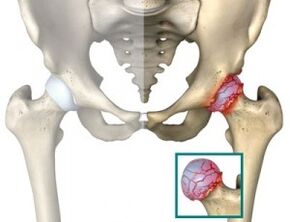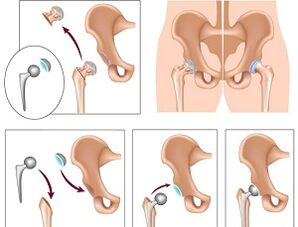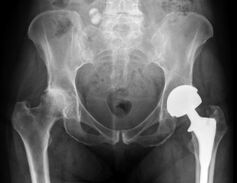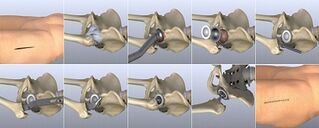
Coxarthrosis is a disease that affects the patient's hip joint. The treatment is long-term. Only a few decades ago, such a diagnosis was a sentence for a patient who practically promised him: severe excruciating pain, a gradual decrease in mobility, and early disability.
However, thanks to the most effective modern methods of treatment, it has become possible not only to stop the degenerative process, but also to completely cure coxarthrosis in the early stages.
Understanding the causes of the disease has led to the use of an integrated approach to therapy. Treatment of osteoarthritis of the hip joint can include both medication and physiotherapy.
What is hip arthrosis
Arthrosis is a disease in which the normal structure of the cartilage tissue of the joints is disrupted. Unlike arthritis, the cause of the deformity is not inflammation of the infected tissue, but a violation of metabolic processes.
With rare exceptions, deformed arthrosis of the hip joint is observed in patients over 40 years of age. The development of pathology is as follows:
- Metabolism is disturbed. There are no blood vessels in the cartilage, so it feeds on neighboring muscle tissue. The synthesis of substances is disrupted for various reasons.
- Cartilage begins to lose elasticity due to malnutrition. It gets thinner over time. The intervertebral lumen is significantly reduced. Grade 3 osteoarthritis of the hip joint is characterized by friction between the growths in the bone tissue. Cartilage is practically absent.
- Bone loading, reducing the thickness of cartilage, helps to deform bone tissue.

After the onset of degenerative changes, it can take years for the patient to develop the third stage of the disease, but under unfavorable conditions and if the measures are not followed, pathological changes can occur faster.
How osteoarthritis manifests itself
The symptoms and nature of osteoarthritis of the hip joint depend on the stage of the disease. The most common symptom is pain. Due to the pain, patients consult a doctor for the most qualified doctor. Moreover, the insidious nature of the disease lies in the fact that in the early stages of degenerative changes, pain, as a rule, does not cause great concern, is short-lived and is often associated with ordinary fatigue.
Delay leads to the most opportune moment to start treatment, and treating grade 2 osteoarthritis requires more time and effort. The probability of a successful prognosis remains the same, provided that the therapy is prescribed correctly.
Symptoms of the disease:
- Pain can be seen in the thighs, groin and joints. Care should be taken if symptoms of pain appear at rest. This indicates the need for an urgent visit to an arthrologist.
- Stiffness of movement, stuttering. It is observed after prolonged inactivity of the leg, for example, after sleep.
- Over time, the patient's leg shortens from the healthy leg, muscle tissue atrophy is observed, it is felt.
In the diagnosis of a disease, nothing can be done without modern diagnostic research. Thus, first-degree hip osteoarthritis is diagnosed only with the help of X-rays, CT and MRI. The figure clearly shows the changes and narrowing of the intervertebral lumen.
Stages of hip arthrosis
After a pathological diagnosis, the patient is given a code corresponding to ICD 10. This is an international classification of diseases that is reviewed every 10 years.
Only statistics are not collected due to the assigned code. The treatments that give the most noticeable results can be chosen. Thanks to international cooperation, the treatment of hip osteoarthritis has improved significantly over time.

In world practice, it is accepted that osteoarthritis of the hip joint has three stages or stages of development. Each has its own symptomatology. Namely:
- The first stage.Painful feelings occur only against the background of extreme stress: running, sports, sports, etc. The pain is mainly concentrated in the joint area. The pain usually goes away on its own after a short rest. In this position, the mobility of the foot remains intact, muscle strength is not limited. Primary osteoarthritis can only be diagnosed by x-ray or tomography. The image clearly shows small deformations of the bone tissue that do not extend beyond the so-called lip. The joint space, as a rule, narrows in uneven areas.
- The second stage.The groin is characterized by migratory pain that begins to spread to the thigh area. It can happen spontaneously during rest. In the second stage, the pain of osteoarthritis in the hip joint does not go away on its own and requires the patient to take an anesthetic. The range of motion is disturbed and atrophy of muscle tissue is observed. The figure clearly shows bone growths and deformities of the femoral head. Perhaps the most loaded part of the thigh - the appearance of a cyst in the acetabulum. In the second stage, the diagnosis of osteoarthritis is made quickly. With such a rapid examination, such pathological changes are obvious. An X-ray or MRI is performed to see the degree of deformation.
- The third stage.The pain becomes chronic. Osteoarthritis can be diagnosed without a thorough examination. The patient can not move without a cane, the pelvis bends, which causes the leg to shorten. When moving, the patient should bend his torso to the damaged joint. As a result, it leads to even greater degenerative changes. The figure shows extensive bone defects. The joint space is almost invisible.
Therapeutic treatment of deformed arthrosis of the hip joint is effective only in stages 1-2 of the disease. The third stage of pathological development often requires surgery.
How to treat osteoarthritis of the hip joint
Regardless of what is used, gymnastics for osteoarthritis of the hip joint or medication, all approaches are based on six basic principles. Namely:
- Take away the pain.
- Provide normal nutrition to cartilage tissue and restore if possible.
- Improve blood flow to the affected area.
- Reduces joint stress.
- Strengthen the surrounding muscles.
- Restore joint mobility.
To achieve the six goals, you need to use complex therapy. Thus, for example, by prescribing injections into the joint, but without paying attention to reducing the load on it, you can deny all the beneficial effects of chondroprotectors. In world practice, it is not surprising that 2 to 10 different approaches are generally applied at the same time, depending on the patient's condition.
How to treat hip osteoarthritis

A comprehensive approach to the treatment of the hip joint gives better results than using only one therapeutic agent - a fact recognized by the world's leading arthrologists. Therefore, it is not uncommon for a patient to be prescribed several of the following treatments at the same time:
- NSAIDs- Non-steroidal anti-inflammatory drugs are "classics" of treatment. Medications for osteoarthritis of the hip joint should be prescribed or included in combination with non-steroidal medications. NSAIDs are especially effective in exacerbation of the disease. They help relieve pain and reduce swelling. Admission allows you to go to exercise therapy exercises, massage, gymnastics and other physiotherapy procedures for osteoarthritis of the hip joint. The disadvantage of NSAIDs is their negative effect on the gastric mucosa. Patients should understand that non-steroidal anti-inflammatory drugs for hip osteoarthritis do not cure the disease, but simply eliminate the symptoms and make therapy possible.
- Chondroprotectors and hyaluronic acid.These drugs are a new stage in the treatment of the hip joint, so they can be divided into separate groups.
- Chondroprotectors are prescribed as restorative therapy. With long-term use, chondroprotectors restore damaged cartilage tissue, but their effectiveness is limited to the early stages of the disease.
- Hyaluronic acid forms a layer between the bones and causes less tension in the joint. It is as effective as restorative therapy.
- Muscle relaxantsare vasodilators that relieve muscle spasm. It is set to reduce the load on the joint. Muscle relaxants can only be used as part of a complex drug treatment.
- Anesthetic Ointment- Despite the claims that ointments are a miraculous remedy for the disease, in fact, they only eliminate the unpleasant symptoms of the disease. On the other hand, painkillers in the form of ointments increase the effectiveness of conservative treatment, which allows to eliminate the swelling and alleviate the patient's condition.
- Intra-articular injections- designed to reduce pain, restore cartilage or protect against excessive pressure in the joint. The most commonly used drugs are corticosteroids. They relieve pain by allowing the patient to begin treatment with physical therapy. The group of corticosteroids may also include hyaluronic acid preparations. The effectiveness of intraarticular injections depends mainly on the experience of the surgeon (according to statistics, 30% of doctors miss the joint capsule when manipulating).
Some medications can be harmful to the body. Self-medication is strictly prohibited!
Hip bandage will relieve stress in the joint and reduce the factor that is the main cause of tissue irritation, which leads to the inflammatory process. Therefore, fixation of the damaged area is often prescribed in conjunction with drug treatment.
Alternative methods and physiotherapy
In addition to prescribing anti-inflammatory drugs, intra-articular injections and other medications, the patient can apply physiotherapy and use non-traditional therapies.
- Manual therapy- this procedure has a milder effect than massage of the hip joint for osteoarthritis in damaged tissues. Any aggressive impact on the affected area can easily trigger the onset of the inflammatory process. Manual therapy is not yet accustomed to in our region, but it is widespread in the West and is one of the official methods of therapy.
- physical therapy for osteoarthritis deformityis a wide area where the patient can choose between traditional and non-traditional methods. Pilates, yoga, as well as water exercises and other methods of restoring atrophic muscle function are popular with hip osteoarthritis. Physical training and moderate strength, in combination with medications, have a beneficial effect and help the patient to recover.
- Traditional medicine- most arthrologists oppose this method as an independent therapy. And there is a foundation of their thoughts. Many patients who refused the help of traditional medicine became disabled. However, under the supervision of the attending physician, effective treatment of osteoarthritis of the hip joint with folk remedies is quite possible. Most of the herbs and infusions used have anti-inflammatory and analgesic effects. Some drug charges have serious contraindications, so you should consult an arthrologist before taking them. It is recommended to use non-traditional alternative methods to treat osteoarthritis of the hip joint with caution. Some recipes not only help to improve, but also cause side effects that lead to rapid destruction of cartilage.
- Homeopathy- helps to normalize the synthesis of substances in the body. Homeopathy is especially effective in post-traumatic osteoarthritis and allows to cope with the main factor that contributes to the development of the disease.
- Apitherapy- treatment with bee stings is very effective, allowing to combine the effects of acupuncture and drug therapy. Not surprisingly, there is a lot of bee venom used in warming and effective ointments. Apitherapy is generally more effective than hip block. The appropriateness of the use of apitherapy should be decided by the attending physician.
- Magnetotherapy- used as adjuvant treatment and prevention of the disease. The effect of magnets increases blood flow to the tissues, helps to restore metabolic processes. Cleanses salt deposits.
- Hirudotherapy- leech therapy has been used for centuries. Leech saliva, which enters the bloodstream, has been shown to contain a substance that promotes its liquefaction. As a result, blood can even enter the atrophied capillaries and blood vessels.
- Mud treatment- has a mild warming effect, helps to get the necessary nutrients. Proper application of mud treatment reduces inflammation and pain. Prohibited with purulent arthrosis of the hip joint. It is prescribed with caution in the presence of blood clots and vascular disease.
- Shilajit for osteoarthritis- used both in pure form and as part of tinctures and compresses. The nutrients that make up the mummy promote tissue renewal. Mummy is especially effective in the early stages of the disease.
- Self-massage- excludes sharp aggressive applause and pressure. It is necessary to ensure blood and lymph flow during massage. A chiropractor or an experienced massage therapist will show you the types and directions of movement.

The use of non-traditional methods at home for osteoarthritis of the hip joint should be complemented by proper nutrition.
Losing just 5 kg reduces the chances of starting the inflammatory process by about 30%.
Hip joint and pregnancy
Pregnancy with osteoarthritis of the hip joint is a double stress for the female body. Most drugs are contraindicated during pregnancy. At the very least, it should be taken very carefully so as not to harm the baby.
If hip arthrosis is in the early stages of pregnancy, it is recommended to delay drug treatment after delivery.
It is possible to give birth with osteoarthritis of the hip joint, but it is necessary to understand all the risks associated with it. Complications after the birth of a child are not uncommon, and the deformation of cartilage tissue occurs at an increasing rate.
When planning a child, it is necessary to undergo a complete physical examination. All medications, ointments, painkillers can be taken only with a doctor's prescription.
Consequences of osteoarthritis
In the later stages of the disease, coxarthrosis becomes impossible to treat normally. Surgery is needed. The operation is a last resort and can be performed in different ways.
- Joint replacement- completely restores all motor functions. The disadvantage of this solution is the limited life of the prosthesis. On average, a second operation is needed to replace it after 15 years.
- Laser therapy for surgical arthrosis of the hip joint- used in case of rejection of the articular part of the bone. Using laser therapy, the damaged surface is removed and replaced with an artificial joint.
All operations are temporary, but without them the patient becomes disabled.
Early diagnosis of coxarthrosis and properly prescribed restorative therapy is the only reliable way to fight the disease. Ignoring the symptoms leads to disability.



































